Despite being very excited about this game and pre-ordering the collector's edition (contrary to my typical avoidance of pre-orders), it took a couple months before I was able to spend much time with it. My strategy guides for Civilization V: Brave New World was a lot of work and took up a lot of time. I was only able to play bits and pieces of Dark Souls II during that time and didn't make much progress. I was hoping to have a review out in time for the PC release, but that didn't happen. Then I was hoping to publish the review before the first DLC hit, but that didn't happen either. I'll probably review the DLC later, once all three have been released.
Full disclosure: I haven't actually finished the game yet, but I do feel that I've played enough of it to be able to write a review. If completing the game changes my opinion considerably, then I will revise this review as I've done with other games in the past (including the first Dark Souls). I've also considered getting the Steam version, since it may be better than the console versions. If I do play that version, I may revise this review to include opinions on that version.
But for now, I've only played the PS3 version,
Table of Contents
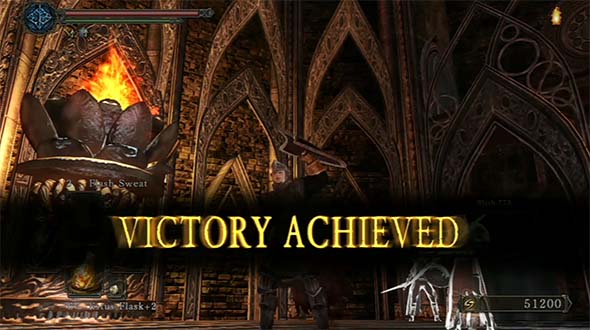
Is Dark Souls II a victorious successor to a masterpiece of design and storytelling?
More versatile action
Combat mechanics have a lot of nuanced changes that really do add to the game experience. There's a much wider variety of attacks and actions that you can perform with most weapons. Certain weapons are now much more focused on specific uses and techniques. For example, there's now a "counter attack" attribute to weapons that is different than the "riposte" feature (which is also changed from previous games). After an enemy begins an attack, you can quickly jab them with a fast weapon (such as a dagger or rapier) in order to do "counter attack damage". This damage type was present in the first Dark Souls (but not Demon's Souls), but it was an invisible quality of the weapon, so many players weren't aware of it.
Because of this new stat, rapiers are specifically geared towards counter, parry, and riposte. If you don't [or can't] counter, parry, or riposte, then your rapiers will feel weak to the point of being useless! This differentiates them much more from other dexterity-based weapons such as curved swords.
In addition to its swinging and spinning attacks [LEFT], the halberd in DSII can be used like a spear [RIGHT].
Other weapons are more versatile and more useful than previous iterations. A great example is the halberd (one of my new favorite weapons). In the previous games, a standard halberd dealt only moderate damage and didn't scale particularly well. It's moveset was slow and clumsy, and so it wasn't very useful in most cases. Now, halberds have multiple different combat styles depending on how you hold it and what equipment you use with it. They have the regular swinging attacks that you'd expect. It also has one-handed chopping attacks that make it behave similar to a long axe. But when paired with a shield, it also has a one-handed thrusting attack similar to a spear or pike (although it consumes more stamina than a similar attack with a spear). This means that the weapon is good at clearing mobs, but can also be used effectively in narrow spaces.
Counter and block mechanics have also changed. Parrying doesn't allow an immediate riposte attack. Instead, it causes the enemy to fall on his butt, which leaves him or her open to a critical attack while prone. If you attack too soon (before the enemy has fallen), you'll do standard damage. This also leaves the player more vulnerable when performing ripostes, which means that elite players can't make themselves invincible by simply parrying and riposting every attack againt them!
You can also now cause a guard break action by repeatedly wailing away at somebody's shield until their stamina is depleted. The guard break staggers the opponent and puts them in a stun lock that allows the attacker to perform a critical attack similar to a riposte in Dark Souls 1. This helps to provide a counter mechanic against extremely defensive players who rely on hiding behind shields.
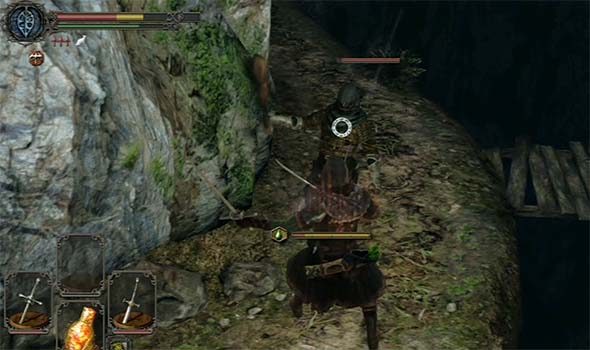
The player is much more vulnerable when riposting - particularly to arrows.
The parry animation doesn't make you invincible as it did in the previous games.
Sorceries and Miracles are also a bit different. The Attunement stat now also increases your casting speed, which means there's actually a benefit to continuing to level it after reaching the spell slot cap.
Lastly, there's a new "Adaptability" stat that increases certain animations such as rolling speed and item use animations (i.e. how quickly you take a swig from the Estus Flask), as well as increase resistances to poison and so forth. This attribute is universally useful and adds even greater flexibility to characters since you can take advantage of these perks with any character class instead of just Dex-based characters.
Back to Table of Contents
Master of the swords
There are also different mechanics for dual-wielding weapons. In the previous games, you could equip a weapon in your left hand, but it wasn't very useful. You could use it to block [ineffectively] or perform an attack, and that was it.
Now, every weapon has a distinct set of off-hand moves, and they interact differently with the weapon in the other hand. Equipping the same weapon in both hands also enables a "power stance" that allows you to attack with both weapons at the same time for added damage. This can make for some more practical and more fun dual-weapon builds, but it does have some problems.

Enemy swordmasters can block by crossing their weapons. Why can't the player do this?
You can't block or parry with most off-hand weapons (rapiers are an exception), and so dual-weapon characters are incapable of defending themselves in places where rolling is not practical. This is somewhat mitigated by the ability to equip three items in each of your hands, so you can always keep a shield as an alternate weapon. But it would still be nice if a block mechanic had been retained - perhaps holding both the right and left shoulder buttons could allow the character to cross the weapons and block attacks? Enemies can block in this fashion; why not the player?
I'm guessing that the "Swordmaster" class (the dual-wielding class) is intended to be for advanced players looking for a more difficult experience, but there's no disclaimer to this effect.
Back to Table of Contents
Useful ranged weapons!
Ranged weapons have also finally been made practical to use as a primary weapon. Early in the game, throwing weapons are particularly damaging, and they are actually worth the soul cost and space in your inventory!
But the real treat is with changes to bows. The biggest change is that you can now move while aiming and drawing the bow or crossbow. This allows you to slowly advance or backpedal, meaning that you can actually engage and fight an enemy with your bow, rather than only being able to make one opening shot then having to switch to a melee weapon as the enemy charges. This opens up whole new styles of play and a wider variety of viable character builds.

New bow mechanics finally make a "ranger" into a viable character build! Except in PvP.
Enemies with ranged weapons have also received another bump in intelligence. They will now lead the player if you are moving so that their arrows or bombs will meet you as you move instead of fall harmlessly behind you. You can't just directly charge every archer or grenadier as you could in the previous game. You need to zig-zag or use a shield in order to approach without taking damage. Ranged enemies are now much more of a threat if you become engaged with another melee enemy. They will now compensate for the movement of battle and can hit you during your combos or dodges, which forces you to think much more carefully about how you deal with groups.

An arrow stuck in mid air.
Unfortunately for rangers, there are still issues with collision detection for projectile weapons. Arrows can still get stuck in thin air and invisible walls, making sniping from a hidden position impractical in many cases.
This may be a good thing, considering that enemy A.I. is still bad at pathfinding, and can sometimes have trouble getting to the player if the player is sniping them from a distance.
Additionally, the range of target lock-on is still limited and doesn't increase as you level up or acquire better bows. So as you move around, you risk leaving the target lock range and causing your character to turn away from the enemy you are fighting. This leaves your back exposed to ranged attacks or charges. It also means that you can't keep far enough away from a PvP opponent to use a bow.
So the new combat mechanics are generally positive. Unfortunately, the other new and changed mechanics aren't as well implemented.
Back to Table of Contents
Let there be light... Or not... It really doesn't matter
The torch was supposed to be a very significant new gameplay addition, and a whole new mechanic was added in which you can light a torch at bonfires in order to illuminate your surroundings. The torch is held in your left hand, so you can't use a shield or secondary weapon while the torch is equipped. And if you unequip it, it is extinguished.
The mechanic as a whole is really stupidly designed though. Very few areas in the game are dark enough to necessitate the use of a torch unless you have the brightness settings on your TV turned all the way down. Even in the few areas where a torch would be useful, I was hesitant to use it because it only lasts for a finite duration and is not regenerated when you rest at bonfires. So I didn't want to risk using up all my torch fuel early and then not having it later in the game if I might need it.
There are some areas of the game where the torch would be useful, but it's never necessary, and I was always hesitant to use it out of the fear of not having it if I ever did need it.
It's a real shame too, because the idea of having to explore dark dungeons, forests, and castles with a torch as your only source of light sounded very appealing to me. Having to use the torch to navigate the environment, avoid traps and pitfalls, spot enemy ambushes, and locate loot would have added a greater sense of adventure to the game. The torch was clearly intended to be an important part of the game, given the overarching themes of light and dark, and considering that you can't walk more than ten steps in most areas without running into a sconce that you're supposed to light with your torch. In my games, most of these sconces went unlit.
Most areas are littered with enemies rather than environmental hazards, and the enemies give away their positions and can be target-locked whether you have light or not. Loot and item drops still sparkle and glow, so you can see them from half a mile a way even in pitch black. This all combines to nullify the torch as a necessary tool for exploration. As it stands, the torch is an optional component in most places, and the worst that will happen is that you might miss a hidden door or secret passage.
Back to Table of Contents
Shaky world balance
In addition to major changes like new combat mechanics and the torch, this game is full of subtle balance changes that dramatically affect the way that the game is played compared to Dark Souls.
One great change is how equipment burden and agility interact. There is no true item burden as there was in Demon's Souls, but the effectiveness of your dodge roll is now inversely proportional to your equipment weight. You don't suddenly become "burdened" at the 50% threshold anymore. Instead, your rolling speed and distance gradually decline as your equipment gets heavier until it hits the "burden" threshold (which is now at 70% instead of 50%).
This allows a wider variety of armors with varying weights and qualities. Mid-weight armor is now much more valuable because the trade-off between mobility and poise isn't a hard line anymore. I do have to note that the Drangleic armor is exceptionally good, and it's very hard justifying any other armor if you have a knight or soldier character.
Weapon skill requirements also don't have the "too heavy" thresholds anymore. Instead, your weapons always swing at the same speed regardless of how heavy they are. But if the weapon requires skills that you don't have, its damage is just ridiculously reduced. This means that you can equip weapons for which you don't have the proper stats and test their movesets to find out it's worth upgrading the appropriate skill(s). Just don't take such a weapon into live combat!
Weapon durability has also been made ridiculously low and weapons take durability damage from the environment (if you attack a wall), so you have to carry multiple back-up weapons with you wherever you go. This compounds the problem of the unlimited item burden and forces you to have to carry redundant equipment, which just clutters up your inventory and takes away any sense of equipping yourself for a given situation! Durability is reset at bonfires, so you also lose the sense of gradual degradation; but if they break completely, then you have to go to a blacksmith. It's also made more annoying by the fact that upgrade stones are in very short supply early in the game, so your backup weapons are generally un-upgraded and pathetically weak.
Back to Table of Contents
Compromises between Demon's Souls and Dark Souls
Some game mechanics seem to have been designed with the idea of combining the best elements of both Demon's Souls and Dark Souls.

Lifegems are consumable healing items that regenerate your health over the course of a few seconds,
and leave you vulnerable in the meantime.
One of my favorite changes is the return of consumable healing items. You still start Dark Souls II with an Estus Flask that can be used to heal your character and which is refilled at each bonfire that you rest at. This flask starts out with very few uses, but as you progress, it will be leveled to allow more uses and improved healing. In the meantime, you can consume healing lifegems form your inventory to heal yourself. These gems can be found as loot in the environment or from slain enemies, or they can be bought from vendors. They don't feel nearly as exploitative as Demon's Souls' healing grasses though, because instead of instantly restoring hit points, they provide a temporary regeneration effect and limit your mobility.
This means that you can still prepare for a new area by stockpiling healing items, but you're still vulnerable after using one, so you have to be able to defend yourself while you wait a couple seconds for your health to recharge. This rebalance also works fairly well in PvP, as it prevents invaders from being invincible by spamming grass (as they could in Demon's Souls), and the host player is less likely to be crippled if he or she has already used up all their Estus.
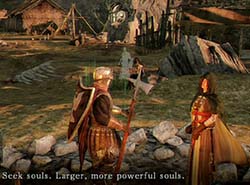
Every time you want to level up, you have to return to the Emerald Herald in Majula and listen to her ramble about seeking great souls.
A less appealing change based on Demon's Souls design is the having to return to a specific character at a specific location in order to level up. In DSII, the Emerald Herald found in Majula acts similalry to Demon's Souls' Maiden in Black. Because of this, every bonfire acts as a warp point, and fast traveling between bonfires is available from the start of the game. This means that the player has to do a lot of warping back and forth to Majula, which requires sitting through a lot of load screens. It also reduces the frequency of backtracking and makes shortcuts much less important. Oh, and you have to listen to her repetitive dialogue every time you visit her.
Back to Table of Contents
Warping around a less compact world
Demon's Souls levels were excellently-designed to feel like long, grueling grinds to get to the boss, but they all had well-placed shortcuts that could be opened that preserved the sense of progress and reduced the tedium of re-grinding through a level to get back to a boss after dying. Dark Souls didn't have as many shortcuts in its specific levels, but its open-world design meant that it had very clever shortcuts between levels that gradually revealed just how compact the world's design actually is. Dark Souls' world felt like a singular place, and every area felt like a utilitarian part of that singular place.
Dark Souls II lacks the elegance of its predecessors' level design. The various branching paths generally lead to dead ends without looping back into other areas. Within the levels themselves, bonfires and bosses are so close together that mid-level shortcuts are rarely necessary; and when a shortcut is opened, it is rarely necessary to use it, since there's usually a bonfire on the other side [that you can warp to] anyway. This has the effect of weakening the sense of Drangleic as a "world", since it feels more like a set of disjoint areas glued together. You might think that this should be a good thing, since it should hypothetically make the game feel more like Demon's Souls (which had a series of linear levels and a central hub location). But the proximity of bosses and bonfires in Dark Souls II takes away the grueling, grinding nature of Demon's Souls' linear levels, making them feel small and bland by comparison.

Bosses in the first half of the game aren't well-balanced.
The Flexile Sentry is pitifully easy (especially with an ally), regardless of character level...
The early-game levels also don't offer a wide enough variety of challenges. You start with access to multiple paths, but some are harder than others. But once you clear one area, the others can seem very easy by comparison. Boss difficulty varies wildly in the first half of the game. The Last Giant feels about right (assuming you didn't already complete the Lighthouse), but The Pursuer and Ruin Sentinels are nigh impossible unless you do other areas first; while the Dragonrider and Flexile Sentry are both complete pushovers no matter how low-level you are (especially since both have an available NPC phantom ally).
Demon's Souls got around this by having each world have a unique set of challenges, so that every world and boss felt challenging, even if you had already leveled up by clearing another world. Dark Souls stayed very linear throughout most of the first 2/3 of the game, so the enemies and bosses were much better balanced as you progressed. But once the world branched out, each of the great lords offered unique challenges.
In addition, the various player classes don't feel very well balanced between each other. Some classes, like the Cleric, don't even have enough skills to effectively use their default weapon. The Swordmaster (dual-wielding class) is also particularly difficult.

... The Ruin Sentinels (which can be fought even earlier than Flexile Sentry) are resilient, hard-hitting, and there's three of them! - and they absolutely require phantom allies.
Back to Table of Contents
A story that focuses more on the character
The story this time around seems to be much more focused around the player character instead of the world (as it was in Demon's Souls and Dark Souls). The opening cinematic is all about the player character becoming cursed and wandering into Drangleic, and as soon as you meet any important NPCs (i.e. the old firekeepers and the Emerald Herald), they are already going on about how you're some kind of special undead who can acquire the great souls to cure your undead-ism.
This is a subtle, but significant departure from the previous games, in which the opening cinematics were focused around the lore and history of the game world and didn't mention the player character at all. Then the player character shows up, and everyone (except maybe the narrator) treats you like you're just one more in a long line of unsuccessful adventurers come to save the world. It's actually kind of depressing to see how apathetic all the characters are, and how nobody seems to give two shits about you. The remainder of the game's narrative is then about how your actions affect the other NPC characters, and how you inevitably change the course of the world's history.
In both Demon's Souls and (especially) Dark Souls, the narrative focus is more on the world than on the player, which helps to create these games' unique and oppressively unforgiving atmosphere.
Eventually, the NPCs start to take you seriously because you've earned it, and suddenly, your role in things becomes significant, and you are declared the "Chosen One" or whatever. The narrative isn't so much about you as it is about how you affect the world. The whole game is designed to educate the player about the interrelations of all the characters, events, and locations, so that when you reach the end of the game, you decide the fate of the world based on what you know. Do you save it? Or let it die?
This really helped to set the tone of the games, built atmosphere, and even helped to make the constant deaths more bearable. You didn't really feel like anything special. You were at the same level as the undead grunts that you fight at the beginning of the game, and you didn't feel cheated if they killed you, since the game has gone so far out of its way to make you feel insignificant. You were just a guy (or gal) looking for adventure or trying to save your own soul and make your way in an unforgiving world. If you acquired any fame or fortune during your exploits, it was because you earned it, and not because you were born with the magic hero blood of destiny.
Because the new game focuses more on the player character instead of the world, the various environments and NPCs just don't seem to have been given the same level of attention. The NPCs all have more dialogue, and some even have more obviously useful information to share, but their personal stories just aren't as interesting or worth interacting with except when necessary. Part of this is because you have to go out of your way to keep NPC stories rolling along. But it is also partly because the Crestfallen Warrior provides what feels like a text dump of the entire game's backstory and objectives right from the start of the game, rather than gradually as you progress. This character makes all the other NPCs feel redundant.
Back to Table of Contents
Losing your humanity bit by bit
One very immersive gameplay mechanic is that each time you die, your character becomes more hollow. Your max health drops (down to a certain percentage) and your character model looks more zombie-like. This fits very well into the story and theme of Dark Souls and it adds a gameplay punishment for sloppy play. If you die repeatedly, your character becomes weaker and weaker.
-

1.) Fully human character.
-
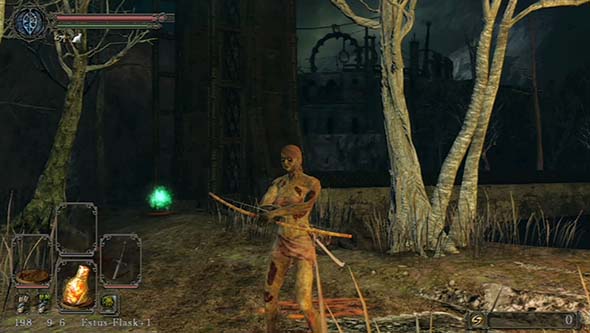
2.) Partially hollowed character looks like a zombie.
-

3.) Fully hollowed character looks like a very decayed zombie.
Gradual hollowing from subsequent deaths is a very immersive, thematic new feature that adds a further punishment for repeat deaths.
This also has the effect of severely punishing poor players. If you die repeatedly to a particular boss, you'll lose max HP, which will only make that already-challenging boss even harder! This is compounded by issues with the online mechanics mitigated and made more tolerable by patches made to the online mechanics (see next section).
I'm torn regarding this feature. On the one hand, I love it thematically; but on the other hand, it is too punitive and only serves to punish players that are already having trouble.
Another related annoying feature is that enemies eventually stop respawning after you kill them enough times. At first, this might seem great! If you are having trouble getting past a certain section, and keep dying to the same one or two enemies that seem to be placed in the most inconvenient of locations, then you can rest assured in the knowledge that if you can just kill them a few times then they'll stop being there. The problem is that if you don't reclaim your lost souls after dying, and the enemies stop respawning, then you have no way to ever recoup those souls. They are just gone, and all those repeat deaths are now in vain! Additionally, once the enemies stop respawning, then you can't go back and kill them with a Gold Serpent Ring in order to get rare drops like upgrade stones.
These mechanics combine to even further punish less skilled players, which seems to be contrary the game's philosophy of having a gentler bar of entry.
Back to Table of Contents
Online backpedaling
FROMSOFTWARE's original design for Dark Souls II's online mechanics were very poorly-received and forced them to make a fundamental change in an early game patch (v1.03).
Show Initial Release commentary Hide Initial Release commentary
Below are my original opinions regarding the game's online design as of the time of the game's release.
A curious design decision is that killing bosses as a phantom no longer revives your character or provides humanity as it did in Demon's Souls and Dark Souls. Instead, there is a consumable inventory item called a "human effigy" that revives the character. This can be found as loot in the world, can be dropped by enemies, or can be bought from vendors.
The problem is that human effigies are in limited quantity. There's only so many of them that you can find in the world, and merchants have limited quantities that they can sell. Additionally, since enemies eventually stop respawning, you can't infinitely farm effigies from enemies. This puts a tremendous amount of pressure on players to conserve this precious supply!
Making humanity a more scarce resource isn't necessarily a bad idea, in principle. After all, it does encourage the player to be sparing and deliberate in their use of effigies, and makes the cumulative HP loss from repeat deaths into much more of an important factor in gameplay. The fact that you can use an effigy at any time - including just outside the boss's fog gate - to restore your humanity, means that you don't have to risk going through the whole level and dying to grunt enemies. This encourages the player to play through most levels in some state of hollowness, with handicapped health.
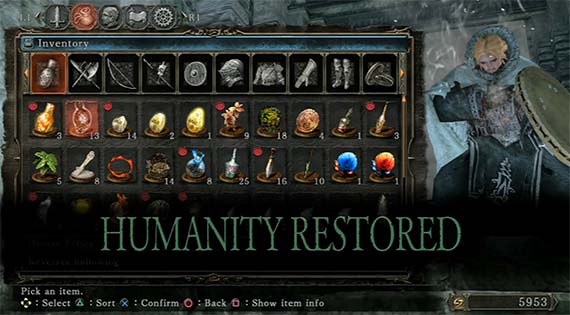
Using a Human Effigy outside of a fog gate. I do not have to return to a bonfire to revive to human!
The problem is that levels aren't very long - especially early-game levels. Bosses are very frequent and very close together, which means that it won't be long before you'll want to revive your character and seek online help. If the levels were longer and more grueling, and more bosses were relegated to mid-level mini-bosses, then summoning allies wouldn't be as important, and the effigy limitations wouldn't be as much of an issue.
Alternatively, the developers could have added additional ways to revive the character. One great suggestion would be for successful invasions to be a way to acquire more effigies or directly restore your humanity. This would encourage further PvP play for all players [of varying skill levels] in all areas of the game!
In any case, there should not be a hard limit on how many times a player can restore humanity! Making it very limited is fine, but there should always be ways to acquire more.
Back to Table of Contents
Since patch 1.03 (and as of the time of this writing), this mechanic was changed. Now, Humanity can be restored from multiplayer co-op, including by being summoned as a Shade via the Small Soapstone. While this addresses the issue of severely limited resurrection capacity, it adds a new issue of making it almost trivial to maintain your humanity and almost completely nullifies the cumulative loss of health from repeat deaths.
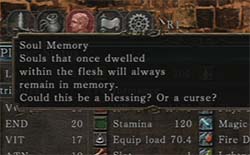
Soul memory can unduly punish less skilled players!
You do have to be careful about overusing online play. There's a new "soul memory" attribute that tracks all of the souls that you've collected over the course of the game, including souls that you gain from online play, and souls that you lost from repeat deaths!
This attribute is supposedly used as the primary determinant for online match-making, and I think it has three primary goals. It seems to be designed to limit the frequency with which overmatched players can assist lower-level players with boss battles. It also seems to be designed to encourage online play by making it harder for power-gamers and speed runners to find coop players with equally low soul levels. It succeeds moderately in these two tasks.
I think the third goal here was to reduce the frequency with which PvPers could gank low-level players. Even if you're rushing through the game and avoiding conflict with enemies in order to keep your soul memory low, you'll still have to defeat bosses in order to progress, which will inflate your soul memory (especially with late-game bosses).
This sounds like a good idea on paper, but in practice, it falls apart for several reasons.
- It doesn't do anything to match players based on skill, so experienced players with fresh characters can still be matched against people who are playing a Souls game for the first time. There isn't much that the designers can do about this without implemented a matchmaking ladder system.
- It also still doesn't do anything to match players based on equipment.
- It unfairly punishes less skilled and/or new players by artificially inflating their soul memory for co-op and PvP. This means that players who are stuck on early-game bosses and who die frequently (thus, losing the souls that they could otherwise have used for leveling or buying equipment, but retaining the soul memory used for match-making) may be less likely to find co-op partners in a given area, are more likely to be matched against higher-level invaders, and they may be less likely to be summoned to other worlds in order to restore their own humanity.
Unfortunately, simply removing lost souls from your soul memory isn't a viable solution. If souls lost from repeat deaths were subtracted from soul memory, then gankers could just speed run the game to get the best gear, spend a bare minimum of souls to upgrade them, and then just die to lose all the excess souls. They would now be on the same level as beginning players with fresh characters. The only real solution is to take equipment ranking into account, but without an item burden, even this has problems.

Soul Memory doesn't prevent highly-skilled players from repeatedly butchering less-skilled players.
Even worse, these elite players are pretty much the only PvP competition that you'll find in the game.
A much better solution to ganking than arbitrary restrictions on match-making would be to change the incentives and availability of PvP play. I've suggested this before, and I'm disappointed that it wasn't implemented in the sequel. PvP items are still few and far between, so new players don't have much of an opportunity to practice outside of the sparring arena (see below). Having greater access to re-usable invasion items, and greater incentive for low-level players to invade would help solve many of the problems with invasions by widening the skill levels of players who perform invasions, thus making it much more likely that players can encounter invaders that can be more easily beaten (instead of just elite players). Instead, the developers even further reduced the frequency of invasions by providing items that you can burn in the bonfires to prevent invasions. I never once used one of these, and I was still rarely invaded!
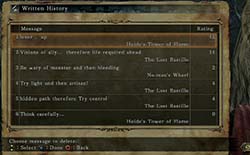
My messages get rated!
At least the message mechanics have been greatly improved. You can now assemble a wider variety of messages from more pieces, leading to greater opportunities for creative and useful hints. Leaving and rating messages is much more intuitive and doesn't require the use of an item, so more messages are present, and more messages get rated! It's just too bad that the reward for a rated message is pretty slim.
It can be annoying when players leave messages in front of secret doors, since the mechanics for secret doors have been changed. In previous games, secret paths were opened by striking the false wall with a weapon. Now, players must press the action button to open secret passages. The problem is that this is the same button that is used for reading messages, and there is no prompt for opening a secret door (because then it wouldn't be "secret" now would it?). This is a problem if a player leaves a hint about a secret door right in front of said secret door, since pressing the action button will only cause you to re-read the message instead of open the door, and you can't toggle to open the door since there isn't a prompt to do so. Argh!
Back to Table of Contents
More Covenants, gods, and sparring leads to fewer invasions
Another big gameplay change is that the character now has four total ring slots and more consumable item slots. Having more item slots also means that you have to scroll through more items in real time to get to the one you want. And if you hit the button one too many times and pass the item, you have to scroll all the way through again. It's a pain, but not a game-breaking flaw. The additional ring slots are a great addition, as they allow the player more freedom to use the special covenant rings (such as the Blue Sentinels' ring) without severely crippling your character. The effects of individual rings are therefore diminished a little bit since you can equip more of them. There is also a special ring that allows you to chose a "patron god" from the game's lore, and it increases the chances of co-op play with other players who have chosen the same god. This ring can be helpful for organizing group sessions, as it makes it more likely that you can find a specific friend; although, it's still not guaranteed. This ring also has the annoying side-effect of preventing NPC summon signs from appearing.

Having more ring slots gives more freedom to equip covenant rings, such as the Blue Sentinels covenant ring that summons you to defend other players from phantom invaders.
Unfortunately, there isn't much Black Phantom activity, and so the dedicated phantom-hunter and PvP covenants are much less appealing than in the first Dark Souls. This will likely only get worse as more people shift to the Steam version of the game, or if a technically-improved version is released on newer consoles. So even though you have extra slots in which to equip a covenant ring or covenant item, they don't feel as useful as they did in the previous game.
Another factor that greatly reduces the frequency of invasions is that there is now early-game access to a sparring mode. This mode requires that you spend a "Token of Fidelity" (acquired by fulfilling your duty as a summoned phantom or shade), and allows you to engage in duels with other players without the risk of losing souls or humanity. I'm glad to see this feature made available early in the game, and I think that having an item requirement is also a great idea, as it gives low-level players an opportunity to practice PvP in a zero-risk environment, while also encouraging them to engage in online play! The early access is a huge step up from the dueling feature that was introduced in the Artorias of the Abyss DLC for the first Dark Souls, since more people (with a wider range of skill levels and soul memory) will actually be using it!
Back to Table of Contents
Failing to fit into an awkward middle-ground between two great games
To FROM's credit, they finally did address some of the nagging legacy technical issues that had plagued Demon's Souls and Dark Souls. Transparency has been implemented to prevent environmental obstacles from completely obscuring the view of the game if they get between the player character and the camera. The ragdoll physics have also been removed so that bodies don't get dragged halfway across the level. Characters have a unique idle stance when in the menus so that other players can see that they aren't necessarily away from the controls if their character isn't doing anything. And the framerate stays steady for the entire game.
Other legacy issues remain. Collision boxes are problematic--especially with projectiles that get stuck in mid air despite a clear vantage point. Characters still have no lip syncing for their dialogue--a moderate immersion-breaker. Weapons (enemy weapons in particular) can still clip through solid walls. Jumping controls are still very uncomfortable. And enemy A.I. and pathfinding can still be suicidally stupid.
Dark Souls II brings a few worthwhile gameplay refinements to the table, and is more technically (and graphically) polished than its predecessors. Its major failings are mostly in the much more subjective fields of design and creativity. In its attempt to appease both Demon's Souls and Dark Souls veterans, while also appealing to a wider audience, the game lands thoroughly in an awkward place where it doesn't do anything especially well. It repeats many story elements, themes, and even boss fights from Dark Souls for no real reason, to the point that it feels lazy. Its attempts to emulate elements of Demon's Souls' design also fall flat because the designers didn't also emulate the larger aspects of that game's overall design (particularly level design) that helped to make the smaller components work as well as they did.
Really? The exact same bosses as in the first game?
Although Dark Souls II is still a good game that should satisfy fans of the series who are longing for new content, it just doesn't feel as inspired as its predecessors did. I think the most telling thing that I can say about DSII is that playing it has given me an even greater appreciation for the design elements of both Demon's Souls and Dark Souls, and makes both of those games look even more like masterpieces by comparison.